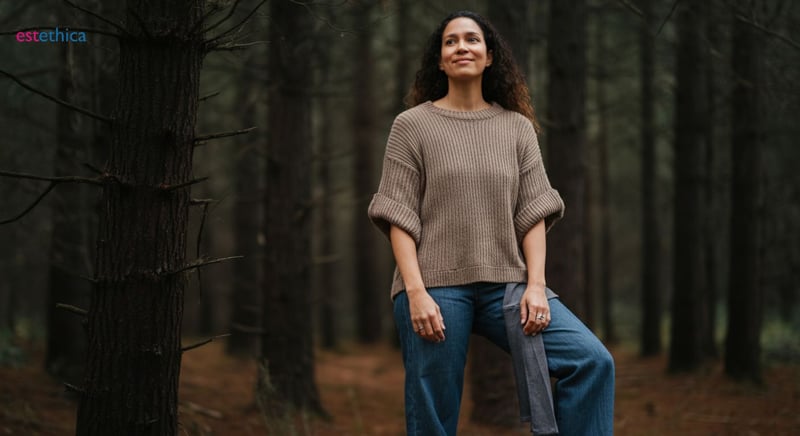Discover the Essence of Eco-Friendly Fashion
Dive into eco-friendly fashion and make a difference with sustainable choices. Discover ethical brands and local stores that lead the green movement. Join now!
The world of fashion is undergoing a profound transformation as more individuals seek to align their wardrobes with their values. Sustainable fashion, eco-friendly clothing, and ethical fashion brands are at the forefront of this change, promising a stylish yet responsible approach to dressing. In this comprehensive guide, we will explore the principles of sustainable fashion, the best materials to choose, ways to support ethical brands, and how to make eco-conscious fashion decisions without breaking the bank. Dive in and discover how you can be part of the fashion revolution while looking effortlessly chic and contributing to a healthier planet.
Understanding Sustainable Fashion: A Comprehensive Guide
The Aesthetics of Sustainable Fashion
Sustainable fashion is not just about environmental impact; it also embraces aesthetics, offering unique styles that appeal to conscious consumers. The aesthetics of sustainable fashion often incorporate natural dyes and organic materials, creating a distinct look that sets it apart from conventional fashion. For instance, brands like Reformation and Stella McCartney focus on eco-friendly clothing that combines style with sustainability. These brands use innovative designs to make sustainable fashion appealing, proving that aesthetics and sustainability can coexist harmoniously.
Key Benefits of Sustainable Fashion
- Reduces environmental impact by minimizing waste and conserving resources.
- Promotes ethical labor practices, ensuring fair wages and safe working conditions.
- Encourages the use of organic clothing materials, which are free from harmful chemicals.
By choosing sustainable fashion, consumers can support a movement that prioritizes both aesthetics and ethics. This approach not only benefits the environment but also enhances the overall quality and longevity of clothing items.
Steps to Embrace Sustainable Fashion
- Research and identify ethical fashion brands that align with your values.
- Opt for eco-friendly clothing materials like organic cotton and recycled fabrics.
- Support local sustainable fashion stores to reduce your carbon footprint.
Embracing sustainable fashion involves making informed choices that reflect a commitment to environmental and social responsibility. By following these steps, consumers can contribute to a more sustainable future while enjoying the unique aesthetics of eco-friendly fashion.
For more insights on ethical practices, explore estethica's Ethical Approach.

Choosing the Best Eco-Friendly Clothing Materials
Understanding the Impact of Eco-Friendly Materials
Eco-friendly clothing materials are pivotal in sustainable fashion, offering both environmental benefits and aesthetic appeal. Organic cotton, for example, is cultivated without harmful chemicals, enhancing soil health and reducing water consumption. This makes it a preferred choice for those seeking sustainable fashion options. Similarly, bamboo and hemp are fast-growing plants that require minimal irrigation, making them excellent for eco-conscious consumers. These materials not only support green fashion but also contribute to aesthetics, providing unique textures and styles.
Key Characteristics of Eco-Friendly Materials
- Organic cotton reduces water usage and avoids toxic pesticides.
- Bamboo and hemp grow rapidly with minimal resources.
- Recycled polyester minimizes landfill waste by reusing plastic bottles.
These materials exemplify how aesthetics and sustainability can coexist, offering stylish options that are gentle on the earth.
Steps to Identify Eco-Friendly Clothing Materials
- Check labels for certifications like GOTS for organic cotton.
- Research brands that prioritize sustainable materials.
- Choose clothing made from recycled or rapidly renewable resources.
By following these steps, consumers can make informed choices that align with sustainable fashion principles, supporting both aesthetics and environmental responsibility.

Finding Affordable Ethical Fashion Brands
Exploring the Aesthetics of Ethical Fashion
Ethical fashion brands are redefining aesthetics by integrating cultural heritage with modern design. These brands often collaborate with local artisans, ensuring that each piece tells a unique story. For example, People Tree works with artisans in developing countries, creating garments that reflect traditional craftsmanship. Similarly, Everlane focuses on transparency, offering consumers insight into the production process, which enhances the aesthetic value of their clothing. Thought, another leader in ethical fashion, uses natural materials and innovative designs to create pieces that are both stylish and sustainable. These brands demonstrate that aesthetics and ethics can coexist, offering consumers beautiful clothing that aligns with their values.
Key Features of Affordable Ethical Fashion Brands
- Commitment to fair wages and safe working conditions.
- Use of environmentally-friendly production methods.
- Support for local artisans and cultural traditions.
By choosing these brands, consumers can enjoy stylish clothing while supporting ethical practices and sustainable supply chains.
Steps to Identify Affordable Ethical Fashion Brands
- Research brands that prioritize transparency and ethical practices.
- Look for certifications that ensure fair trade and sustainable production.
- Explore collections that highlight cultural aesthetics and craftsmanship.
These steps can guide consumers in making informed choices that align with their ethical and aesthetic values, contributing to a more sustainable fashion industry.

Exploring Local Sustainable Fashion Stores
The Aesthetic Appeal of Local Sustainable Fashion
Local sustainable fashion stores offer a unique aesthetic experience that combines eco-friendly clothing with community support. These stores often feature handcrafted garments that reflect the cultural aesthetics of their location. For example, a boutique in New York might showcase upcycled fashion pieces that highlight the city's vibrant art scene. In Los Angeles, eco-friendly clothing shops often incorporate organic clothing materials, creating a laid-back, yet stylish aesthetic. Meanwhile, in London, ethical fashion brands frequently collaborate with local designers to produce fair trade apparel that resonates with the city's rich history and modern flair. These stores not only provide unique fashion finds but also foster a deeper appreciation for the craftsmanship involved, enhancing the overall shopping experience.
Benefits of Supporting Local Sustainable Fashion Stores
- Reduces carbon emissions by minimizing transportation needs.
- Supports local economies and encourages community growth.
- Offers unique, handcrafted garments that reflect local culture.
By choosing to shop at local sustainable fashion stores, consumers can enjoy the aesthetics of eco-friendly fashion while contributing to a more sustainable and vibrant community.
Steps to Discover Local Sustainable Fashion Stores
- Research online for sustainable fashion stores in your area.
- Visit local markets and fairs to discover new eco-friendly brands.
- Engage with community events that promote ethical fashion practices.
These steps can help consumers find local stores that align with their values, offering a unique blend of aesthetics and sustainability. By supporting these stores, individuals can enjoy the benefits of sustainable fashion while fostering a closer connection to their community.
Innovative Eco-Friendly Fashion Materials
Embracing Local Sustainable Fashion
Frequently Asked Questions
What is sustainable fashion and why is it important?
How can I choose the best eco-friendly clothing materials?
What are some affordable ethical fashion brands I can explore?
How can I find local sustainable fashion stores?
Why should I choose eco-friendly clothing over conventional options?
Discover the art of healthy beauty with estethica's award-winning services. Call now for your free consultation and take the first step towards a more confident you!
📞 Speak with Our Experts Today!